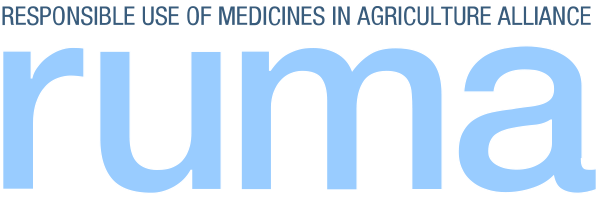
RUMA logo
Latest RUMA Targets Task Force Report Reveals That Despite An Unprecedented Year, UK Livestock Sectors Are Making Good Progress On Antibiotic Use Targets
The ‘one year on’ RUMA Targets Task Force 2 (TTF2) report has been released today, summarising the first year’s progress against the second set of antibiotic use targets which span 2021-2024.
The report highlights where targets are already being achieved or sustained, and where challenges remain. It reveals that for some sectors it is still too early in the four-year targets cycle to provide accurate data, but where data is provided it indicates good first year progress, despite the challenges of the global pandemic and the UK’s exit from the EU.
The summary report covers ten sectors across aquaculture, pigs, poultry and ruminants.
This ‘one year on’ review provides the first annual progress update towards the second set of TTF2 goals across all UK livestock sectors for data collection, use of antibiotics, uptake of preventative measures such as vaccines and training, and the development of industry initiatives. The latest targets build on the successful implementation of the last targets released back in 2017 which helped to halve sales of antibiotics to treat UK farm animals and achieve the fifth-lowest usage in Europe, with only Nordic countries lower1.
The unprecedented nature of the past year has resulted in significant industry challenges including supply chain resource and infrastructure issues, and labour difficulties. These unique set of circumstances have had far reaching and varying impacts some of which, are yet to be fully understood across the farming industry and the journey towards the targets.
As a result of these global and political impacts some sectors such as gamebirds had reduced production and others such as the pig sector, experienced considerable supply chain issues with animals remaining on farm for significantly longer periods of time than normal. This means that some of the figures reported are not representative of a ‘normal’ year of activity. In addition, the process the sectors have gone through to work towards their targets has in some cases, also been unavoidably affected and caused delays to the development and launch of key initiatives. It is not yet known the full effect this will have on the targets and how long it will take for these impacts to be felt, understood, and addressed. Equally, the report shows that the onset of environmental issues related to global climate change have had impacts in some sectors too.
Cat McLaughlin, RUMA Chair & Chair of the RUMA Targets Task Force 2 says: “Despite an exceptional 12 months, there have been some great achievements realised in year one of the second set of RUMA Targets Task Force targets, which is testament to the hard-work and commitment across all sectors. As well as striving to achieve or sustain key targets a number of important industry initiatives have also been launched including Farm Vet Champions and the Medicine Hub.
“Events of the past year have undoubtedly affected the industry in many ways, but producers, vets, and wider industry, have continued to manage with the utmost professionalism and commitment to the responsible use of antibiotics through this challenging time.
“It is important to remember that the targets are not about driving towards zero antibiotic use; antibiotics are needed when necessary as a tool to treat sick animals and to improve and maintain animal welfare. Each sector will ultimately reach a sustainable level below which further reductions could negatively impact animal welfare. For now, efforts to maintain or continue reductions across most sectors are delivering good results, but it is to be expected that usage is beginning to level out or even bounce back a small amount in some cases where sustainable use has been achieved.”
When considering the key challenges that still lie ahead, Cat says: “Collation of robust data remains a priority especially in the ruminant sectors. Industry level data and figures are essential to illustrate the general direction and provide focus for sector activities, but farm level data is also vital and gives farmers the autonomy to set their own goals and targets to achieve realistic and sustainable levels of responsible use. Equally, we know that global climate change remains an ongoing challenge for agriculture as we move forward.
The Veterinary Medicines Directorate’s (VMD) Veterinary Antimicrobial Resistance and Sales Surveillance (UK-VARSS 2020) report, was also released today, and shows that UK antibiotic sales for food-producing animals have reduced by 52% (when sales were recorded at 62.3 mg/kg).
Abigail Seager, Chief Executive of the Veterinary Medicines Directorate, said: “Working closely with the farming industry and the veterinary profession, we have achieved huge reductions in the use of antibiotics since 2014 and we are seeing reductions in resistance as well.
“These successes are testament to the cooperation between farmers and vets in promoting the responsible use of antibiotics.”
The full RUMA Targets Task Force 2 ‘year one’ summary report can be viewed here: Home - Responsible Use of Medicines in Agriculture Alliance (ruma.org.uk)
1 European Medicines Agency (2020). Sales of veterinary antimicrobial agents in 31 European countries in 2018: Trends 2010-2018 (Iceland, Finland, Norway and Sweden are the countries with the lowest sales).
More from RUMA
- RUMA Agriculture Targets Task Force releases third cycle of AMU targets for UK livestock sectors
- Latest RUMA Agriculture Targets Task Force report released - the last of the TTF2 cycle marking another important and valuable phase in the livestock industry’s antibiotic stewardship journey ahead of TTF3 launch
- RUMA CA&E announces National AMU Reduction Targets for companion animals
- Latest RUMA Targets Task Force report reveals UK livestock sectors continue to make positive progress on antibiotic use targets
- RUMA 2023 conference - a one health view on the responsible use of medicines

 4 years ago
4 years ago  1153 views
1153 views